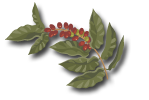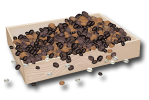THERE IS NO OTHER COFFEE QUITE LIKE IT
_______
The Geisha story is one of both revival and of progress. It is a bridge that connects a rich history to a bright and quickly changing future in the world of coffee. This tree, and the beans it produces, is at once a beacon pointing the way towards a coffee landscape we all want to see and a deliverance of sorts—a cup of Geisha can provide something as close as we’ve seen to perfection in coffee, a sensory rapture that is nothing short of inspirational.
There is no other coffee quite like it. It is an extremely aromatic coffee, which you notice as soon as the water hits the cup – you can detect the sweet floral, citrus blossom, jasmine and sweet honey fragrances immediately. A bergamot-like finish and a distinct though delicate acidity are typical for its cup profile.

YEARS UNTIL MAXIMUM PRODUCTION
HEIGHT OF A COFFEE TREE IN MILLIMETERS
%
SUN TO SHADE RATIO
YEAR GEISHA WAS REDISCOVERED
GEISHA VARIETAL IS DIFFERENT FROM OTHER VARIETIES IN MANY WAYS
The Geisha tree is an elegant thing of beauty. It grows very tall and features distinctly shaped and elongated leaves, cherries and beans.


 The story starts in Ethiopia, the birthplace of Arabica and the only place on earth where the species grows wild. Back in 1931 a group of botanists made an expedition into the forests of Southwestern Ethiopia (called Abyssinia at the time) to collect coffee seeds in an area that was referred to by locals as “Geisha”. Those seeds were taken to Kenya and planted in a nursery to grow. After five years the trees were bearing fruit and at that point several selections were taken from the healthiest, most vibrant trees and brought to other gardens in Uganda and Tanzania. Nearly two decades later, in 1953, some Geisha seeds from the Tanzania garden were taken to Costa Rica to be added to the collection of varietals being studied at CATIE, the world-renowned agricultural research center.
The story starts in Ethiopia, the birthplace of Arabica and the only place on earth where the species grows wild. Back in 1931 a group of botanists made an expedition into the forests of Southwestern Ethiopia (called Abyssinia at the time) to collect coffee seeds in an area that was referred to by locals as “Geisha”. Those seeds were taken to Kenya and planted in a nursery to grow. After five years the trees were bearing fruit and at that point several selections were taken from the healthiest, most vibrant trees and brought to other gardens in Uganda and Tanzania. Nearly two decades later, in 1953, some Geisha seeds from the Tanzania garden were taken to Costa Rica to be added to the collection of varietals being studied at CATIE, the world-renowned agricultural research center. Then in 1963 a farmer by the name of Pachi Serracin brought some of these seeds to Panama and planted them at high altitude in the volcanic soil of Boquete. At this point they were nothing but a curiosity—a “why not?” proposition—and after a few years of cultivation it seems they were basically abandoned due to their low yields and lack of sturdiness. Soon after they were all but forgotten, becoming nothing more than a bunch of weak looking trees growing amongst the legions of Caturra and other common Latin varietals.
Then in 1963 a farmer by the name of Pachi Serracin brought some of these seeds to Panama and planted them at high altitude in the volcanic soil of Boquete. At this point they were nothing but a curiosity—a “why not?” proposition—and after a few years of cultivation it seems they were basically abandoned due to their low yields and lack of sturdiness. Soon after they were all but forgotten, becoming nothing more than a bunch of weak looking trees growing amongst the legions of Caturra and other common Latin varietals. But in 2003 something changed. Daniel Peterson of the Esmeralda Estate had noticed this patch of trees that were distinctly different than everything else. Up until that point they would generally been harvested together with the other coffees and mixed into other lots. After harvesting the coffee separately and tasting it in his lab he and his family recognized that it tasted dramatically different than anything else they were producing. Out of curiosity, they decided to submit the coffee to the Best of Panama competition to see what happened. They were not at all sure whether people would like it or whether it would be dismissed as an aberration from what was then considered the typical “profile” for Panamanian coffees.
But in 2003 something changed. Daniel Peterson of the Esmeralda Estate had noticed this patch of trees that were distinctly different than everything else. Up until that point they would generally been harvested together with the other coffees and mixed into other lots. After harvesting the coffee separately and tasting it in his lab he and his family recognized that it tasted dramatically different than anything else they were producing. Out of curiosity, they decided to submit the coffee to the Best of Panama competition to see what happened. They were not at all sure whether people would like it or whether it would be dismissed as an aberration from what was then considered the typical “profile” for Panamanian coffees. What occurred next was nothing short of a coffee revolution. Amongst the 25+ finalist coffees, there was one that had all the judges simultaneously delighted and confounded. You could smell it from across the table—beautiful jasmine, lemongrass, coffee-blossom, sweet lime and white peach aromas drifting through the room. The competition was over before it began. This coffee had enchanted everyone on the jury, and from round one onwards it was clear that it was going to win by a landslide. What followed was a series of performances that helped the Geisha cement itself as more than just a flash in the pan. With rare exception, this Panama Geisha coffee has won every competition it has entered for almost a decade. To this day, Geisha continues to sit alone on the throne as the reigning champion varietal in the Latin American coffee landscape.
What occurred next was nothing short of a coffee revolution. Amongst the 25+ finalist coffees, there was one that had all the judges simultaneously delighted and confounded. You could smell it from across the table—beautiful jasmine, lemongrass, coffee-blossom, sweet lime and white peach aromas drifting through the room. The competition was over before it began. This coffee had enchanted everyone on the jury, and from round one onwards it was clear that it was going to win by a landslide. What followed was a series of performances that helped the Geisha cement itself as more than just a flash in the pan. With rare exception, this Panama Geisha coffee has won every competition it has entered for almost a decade. To this day, Geisha continues to sit alone on the throne as the reigning champion varietal in the Latin American coffee landscape.





